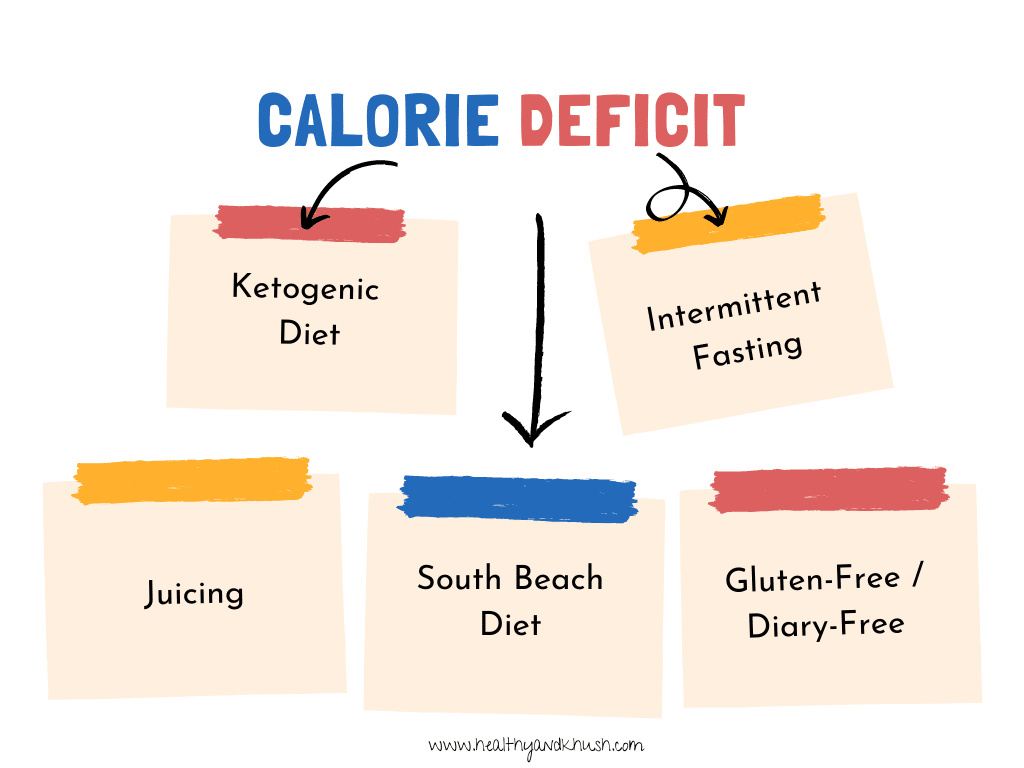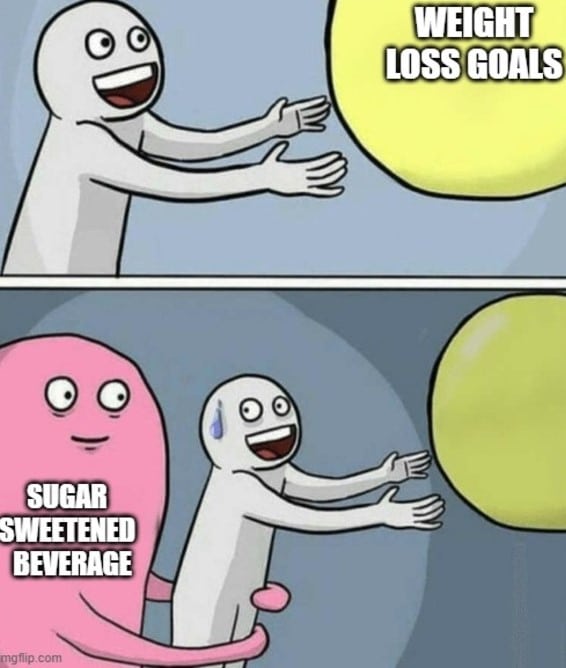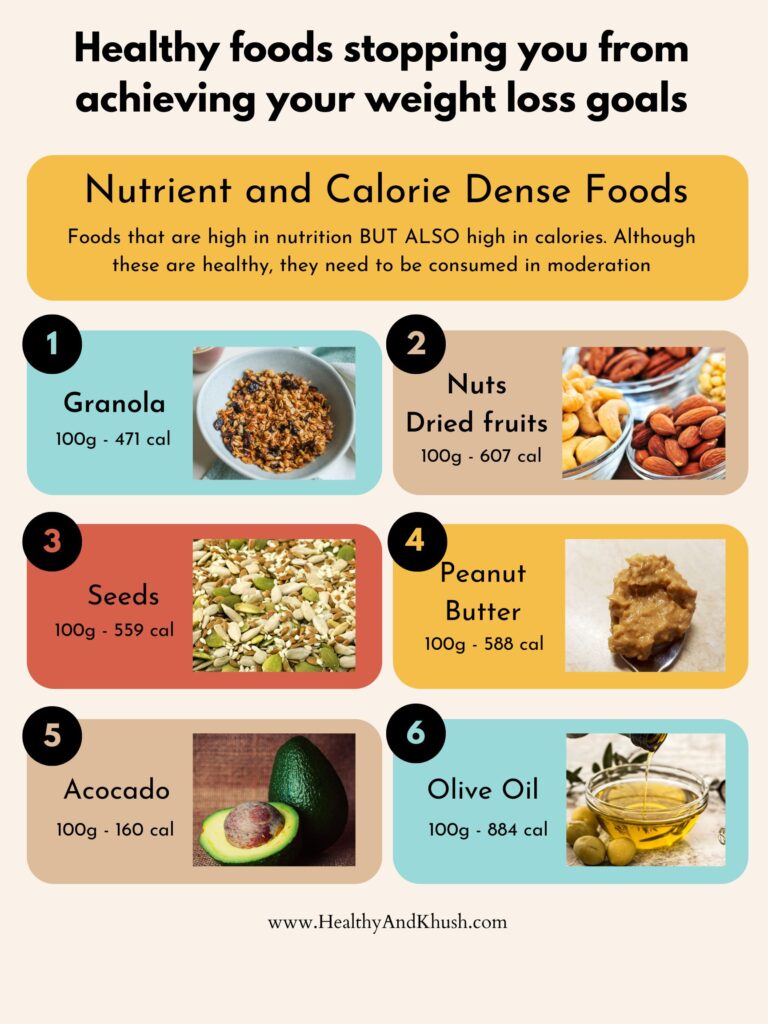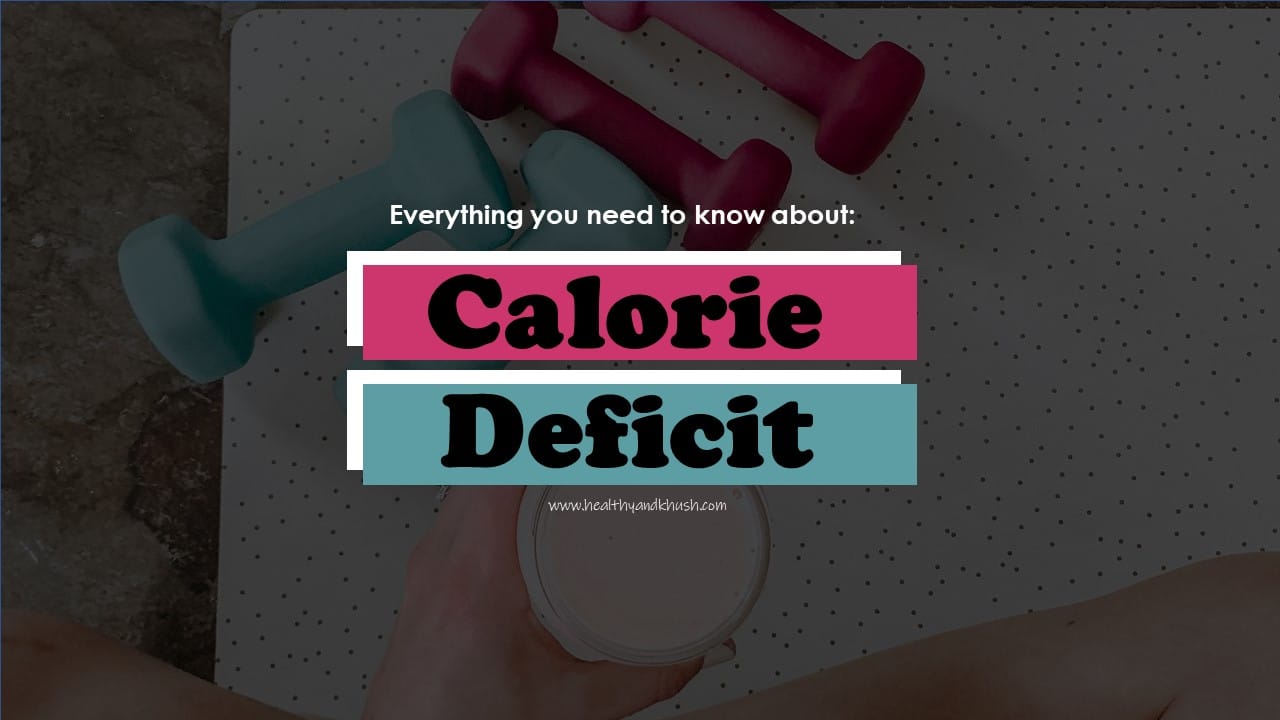Every few years we hear about a new magical diet which is super effective. Keto, Intermittent Fasting, South Beach, Paleo. And the list goes on.
But honestly, the fact is that all the diets out there, every single one of them, works on a single principle: Calorie Deficit.
After you understand the concept of Calorie Deficit, you will be able to take charge of your weight loss journey. Setting you free from the “diet culture”!
For this very reason, I have created an extensive guide giving you all the information you will need. Consider yourself warned as this is going to be a long read.
Basic concepts around calories:
Before we talk about calorie deficit, let’s start by understanding a few basic concepts around calories.
What is a calorie?
A calorie, in simple terms, is a unit of energy. 1 Kilocalorie (kcal) is the amount of heat required to raise the temperature of 1kg water by 1 degree.
What is a calorie in food terms?
Well, a calorie in food is the amount of energy we get from that particular food. All types of food (irrespective of it being proteins, carbs, or fats) give our body energy. Our body uses this energy to carry out all its functions, from moving around to pumping blood in our veins and breathing.
What is energy balance?
Energy balance is the relationship between the calories you consume (from food and drinks) and the calories you burn (physical activity and body functions). Often also referred to as Calories In vs. Calories Out (CICO).
What are the types of energy balance?
There are 3 types of energy balance a person can be in:
Calorie Maintenance is when you consume the same number of calories as you burn. This is where the weight is maintained.
Calorie Surplus is when you consume more calories than you burn. These excess calories are stored in the body as fats, leading to weight gain.
Calorie Deficit is when you consume fewer calories than you burn. This is what leads to weight loss.

Okay, so now let’s look at Calorie Deficit in detail.
What is a calorie deficit?
Calorie Deficit is when the calories you consume are lesser than the calories you burn. In this state, the body uses the stored fat as an energy source, leading to weight loss. Calorie Deficit can be created either by consuming less or burning more calories.
It is important to note that calorie deficit isn’t a diet. Instead, it is the concept on which all diets are based on. So, there aren’t any fixed rules or strategies to follow. Instead, it is about finding what works for you. Anything that lets you consistently be in a calorie deficit will help you lose weight over a long time.
How popular diets create calorie deficit
Let us take an example of 2 popular diets and see how they help create a calorie deficit.
Intermittent fasting restricts your meal timings to create a calorie deficit.
IF doesn’t put restrictions on any type of food but instead gives you a timeframe to eat your meals. To stick to this timeframe, you need to either skip breakfast or dinner. Either way, you end up reducing anywhere between 250-600 calories from your day.
Keto (ketogenic) diet restricts an entire food group to create a calorie deficit.
The Keto diet lets you eat whenever you want but puts restrictions on carbs, one of the primary sources of calories. When you cut out an entire food group, the number of things you can eat reduces drastically – out goes all the bread and rice and pasta. This way, you end up consuming far lesser calories than usual.

But then you might wonder, why are you not losing weight even though you are following keto or IF.
Why these diets don’t work?
Well, the reason for a diet to fail is our unhealthy eating habits. These diets are designed on the basic principle that we will continue to eat sensibly while following the diet. But we humans always find loopholes in everything. I remember a colleague in the office complaining about IF not working for him. But one day, I saw him eat a Cheesecake Factory cheesecake as an afternoon snack. That cake, as delicious as it is, is over 900 calories!! Which is nearly 2 full meals! His justification was that he was eating it in the “eating window,” so it should be okay.
Well, having a 900 calorie cheesecake daily (in addition to your meals) and expecting to lose weight sounds slightly stupid to me. Don’t get me wrong. By no means am I saying you shouldn’t eat sweets. I love sugar and have written an entire post on how you can eat sugar and still lose weight.
But you get the point, right? It isn’t about blindly following the rules. Instead, it is about forming healthy habits and making sensible choices that work for you in the long term.
Personally, I can’t follow a ‘diet.’ I love food, and eating makes me happy. So, I prefer calorie cycling.
The bottom line: It is about following what works for you and lets you be in a calorie deficit over a long period of time.
How to calculate the calorie deficit per day?
To calculate your calorie deficit, you first need to know how many calories you need to maintain your current weight – the maintenance calories.
What does maintenance calories mean?
The body requires a certain number of calories every day to perform essential bodily functions and physical activities. These include everything from breathing, beating of the heart, and digestion to working out and fidgeting. The total calories required to do all of these and still maintain the current body weight is maintenance calories. It is also known as Total Daily Energy Expenditure (TDEE).
The TDEE consists of 4 components. These are the 4 ways the body burns calories.

- Basal Metabolic Rate (BMR) – these are calories the body needs only to survive. It includes breathing, blood circulation, cell regeneration, the beating of the heart, etc.
- Thermic Effect of Food (TEF) – these are calories burned in the digestion of food. It depends on the quantity and type of food.
- Thermic Effect of Exercise (TEE) – these include calories burned during a workout. It can be any workout – kickboxing, yoga, pilates, strength training, etc.
- Non-Exercise Activity Thermogenesis (NEAT) – these are calories burned by non-exercise activities. It includes everything from walking, fidgeting, and doing home chores.
Calculating the maintenance calories
Numerous equations can be used to calculate maintenance calories, and most of them give a similar range. So, don’t stress too much about which is the most accurate. Also, since all our bodies are different, this number will vary anyways. However, the calculation below will provide a good starting point.
Step 1: Determine your multiplier basis the activity level from the table below
Step 2: Multiply your body weight in pounds with this number
(bodyweight in pounds = 2.2 x bodyweight in kgs)
| Lifestyle | Multiplier |
| Sedentary (little or no exercise and desk job) | 12 |
| Lightly active (workout 2-3 hours/week) | 13.75 |
| Moderately active (workout 3-5 hours/week) | 15.5 |
| Very active (workout 6-7 hours/week) | 17.25 |
| Extra active (very hard exercise/sports & physically active job) | 19 |
Let’s assume my weight is 65kg, and I have a moderately active lifestyle. So, my maintenance calories will be 65 x 2.2 x 15.5 = 2216.5 calories
If you are confused between 2 options while picking the multiplier, always pick the lower one. 🙂
PS: The only way to know your exact maintenance calories is to track your weight and calories (while maintaining the same activity) for over 10-14 days.
Calculating the calorie deficit
After knowing maintenance calories, it is pretty easy to calculate the daily calorie deficit.
A rule of thumb is that a deficit of 7000 calories will help you lose 1 kg (2.2 lbs). So, by creating a daily deficit of 500 calories (from your maintenance calories), you can lose approximately 0.5kgs in a week.
300-500 Calorie Deficit is considered ideal while trying to lose weight. It promotes fat loss but doesn’t cause excessive hunger and laziness. Even if you decide to do an aggressive calorie deficit, it is crucial to ensure that your weekly calories don’t go below your BMR.
PS: The 3500-calorie rule is NOT 100% accurate, and the rate of weight loss varies among people based on numerous factors.
Or, you can use the below calculator:
Quitck note: The above calorie count isn’t a “magic number”, it’s an estimation at best. I recommend you give yourself a leeway of at least 100 calories. Now with this flexible mindset, let’s see how we can create this deficit…
How to create a calorie deficit?
Most people think that the ONLY way to lose weight is by eating less. Sure, food plays a very important role in your weight loss journey. But there are 3 ways in which you can create a healthy Calorie Deficit.
- Eating less food – consuming lesser calories
- Being more active – burning more calories
- Eating less food and being more active – consuming lesser and burning more calories
All the ways mentioned above work perfectly. However, I believe the healthiest way to create a calorie deficit is by eating less food AND being more active. This way, I don’t feel like I am compromising the food too much and have enough energy to increase my NEAT, creating the additional deficit I am looking for. Honestly, it is about finding the combination you enjoy the most.
Tips for consuming fewer calories
1. Eliminate liquid calories
Most drinks, especially sugar-sweetened beverages, are super high on calories and low on nutrition. Eliminating these from your diet can show immediate results.
I have written an article on how long it takes to lose weight after quitting soda, which will give you all the additional information you need.

2. Skip processed food
Another quick and easy way to reduce calories is by skipping processed food. These again have a high-calorie, low-nutrition profile, making them an enemy of weight loss.
Having said this, the world we live in won’t allow us to eliminate them from our diets. So, try and consume them as sparingly as possible.
3. Choose low-calorie options
Try and pick low-calorie options vs. their high-calorie counterparts. This could be,
- Replace regular soda with diet soda.
You’ll be surprised with the affect a single can of coke can have on your caloric intake. - Adding grapes in a salad instead of raisins
- Using skimmed milk instead of full fat
- Having home-cooked meals instead of fast food
The possibilities are endless, and again, there is no right and wrong. It is about what works for you and what lets you create a deficit easily.
4. Read the food labels
Often, a lot of us tend to confuse the packet portion for the serving size. This ignorance can result in hundreds of extra calories. Chips are a classic example of this error.
Knowing serving size is also crucial because we consume a much larger portion than what is recommended for certain things. An example of this is granola. A standard serving of granola as per most packs is 40-45g, just about 3 tablespoons! I don’t know anyone who can eat only 3 spoons of granola for breakfast and be satisfied. Keeping this in mind, it is also crucial to…
5. Beware of the ‘healthy’ foods halo
Some healthy foods are often unconsciously consumed in huge quantities. They are high on nutrition(micro-nutrients), but the quantity piles up the calories quick quickly with them. Here are some examples:

Chances are that you will end up skipping a lot of nutritious food high in calories to create your daily deficit. In that case, I recommend including high-quality health supplements during your deficit phase, so you aren’t lacking in any of the essential micronutrients.
6. Portion control
Taking smaller servings and controlling the food portions can go a long way for weight loss. Also, don’t eat directly out of food packets as it makes controlling portions impossible.
Ensure that you eat only when you are hungry and not because you are bored or sad. Read this article to know how to stop emotional eating.
7. Up your protein intake
Alright, I know you have heard of this a gazillion times already, and I am probably the captain obvious here. So instead of just saying, “Have more protein” let me tell you 3 reasons why you should be increasing your protein intake:
- Protein is the most satiating macronutrient – Hunger is one of the biggest hurdles when trying to lose weight. And increasing protein intake can significantly reduce your hunger levels.
- Protein helps you retain your muscle mass – During deficit, your body loses fat, but also muscle. And protein is the only macro-nutrient that can build and maintain muscle mass. And it matters because muscle mass makes you burn more calories. So during a deficit, it’s important to preserve this muscle mass.
- Protein has the highest thermic effect – In simple terms, your body burns more energy to digest protein than carbs or fat.
Tips for burning more calories
1. Beware of the halo effect of workouts
Many people believe that their daily activity quota is done if they work out for an hour during the day. In addition to that, most people tend to overestimate the calories burned during a workout.
The calorie counters in most wearable fitness trackers and equipments aren’t as accurate as we want to believe. We say this because we have extensively researched most of the best ellipticals and top-rated exercise bikes in the market. There are studies claiming this as well! [1], [2]
Both situations lead people to falsely assume that they have burned enough calories to create the required ‘Deficit.’
2. Increase your NEAT / NEPA (non-exercise physical activity)
This is the calories burned from all the activities other than exercise. NEAT [3] can result in a difference of over 2000kcal burned per day between 2 individuals of similar size, making it a game-changer for weight loss. For very sedentary individuals, NEAT can be as low as 15% of the total calories burned per day. For extremely active people, it can account for over 50% of the total calories burned per day.
The way I like to look at this is if I increase my NEAT, I get to eat more, which is brilliant!
Some simple ways to increase NEAT can be:

- Walking when you talk on the phone
- Taking the stairs instead of the elevator
- Choosing the longer route to the washroom/cafeteria at work
- Standing instead of sitting wherever possible – office or home
- Hula hooping (my favourite) while watching Netflix (I do this!)
Burning as little as 100 calories more each day can lead to an additional weight loss of nearly 5kgs per year. So trust me, every small thing you do will count.
Frequently asked questions around Calorie Deficit
Do you need to track calories to be in a calorie deficit?
No, you don’t need to track calories to be in a calorie deficit, but it can get much easier if you do. This is because it lets you be sure that you are in a calorie deficit, and it isn’t a guessing game anymore.
I know counting calories can be annoying and tedious. But there are a lot of calorie-tracking apps which can make the task easier. The one I like is MyFitnessPal. For anyone who isn’t very keen on tracking calories, my suggestion would be to do it anyways for 4-6 weeks. It will help you get some basic estimates. After this exercise, you will be able to ballpark calories in most of your regular foods.
How to create a calorie deficit when your caloric intake is already low?
You can create a calorie deficit by getting more active and increasing your NEAT when your calorie intake is already low. We all know that calories can’t be reduced after a certain level, so increasing physical activity can bridge this gap.
How to create a calorie deficit when you’re already small?
Again, you can create a calorie deficit by getting more active and increasing your NEAT when you’re already small.
How to create a calorie deficit but not lose muscle mass?
Consuming enough protein at every meal and strength training 3 to 5 times a week will ensure that you don’t lose muscle mass while on a calorie deficit. Also, by making sure that the daily calories are not lower than the BMR.
One of the easiest ways to maximise your daily protein intake is by including protein powders in your diet. Check out the best protein powder that fits your goals.
Can you eat whatever you want in a calorie deficit?
Yes, you can eat absolutely whatever you want in a calorie deficit. But it is advised that you eat low-calorie and high-nutrient foods. This will give you all the required nutrition while keeping you fuller for longer. If you consume calorie-dense foods, you won’t feel full, so being in a calorie deficit will become difficult.
What are good calories and bad calories?

There is NOTHING like good calorie and bad calorie. A calorie is a calorie, regardless of where it comes from. Remember, it’s just a unit of measurement; there’re no feelings attached to it.
Popularly, calorie-dense food is referred to as ‘bad calories’ because they are high in calories and low in nutrients. Some examples would be sugary beverages, processed & junk food, etc. Similarly, nutrient-dense foods are referred to as ‘good calories’ because they are high in nutrition and low in calories. These include fruits, vegetables, whole grains, etc.
Ideally, when trying to lose weight, it is best to avoid calorie-dense food. It doesn’t mean any food or calorie is good or bad. Always remember, ‘No food is evil, the quantity we consume is!







